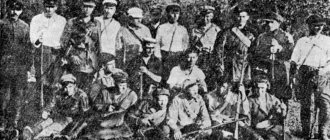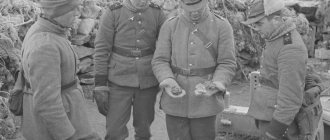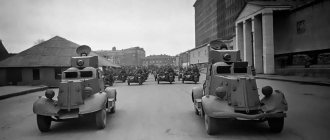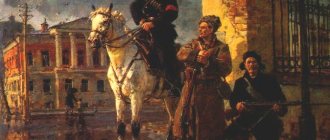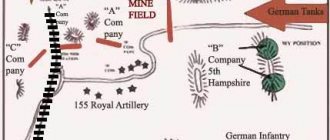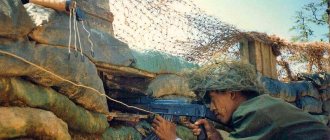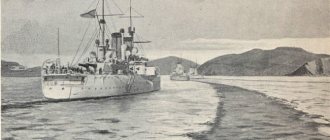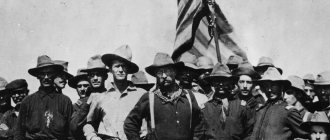Where did the terms "red" and "white" come from? The Civil War also saw the “Greens”, “Cadets”, “Socialist Revolutionaries” and other formations. What is their fundamental difference?
In this article, we will not only answer these questions, but also briefly get acquainted with the history of the formation of Soviet power in the country. Let's talk about the confrontation between the White Guard and the Red Army.
Origin of the terms "red" and "white"
Today, the history of the Fatherland is of less and less concern to young people. According to polls, many have no idea who Lenin is, let alone the Patriotic War of 1812...
However, such words and phrases as “red” and “white”, “Civil War” and “October Revolution” are still heard. Most people, however, do not know the details, but they have heard the terms.
Let's take a closer look at this issue. We should start with where the two opposing camps came from - “white” and “red” in the Civil War. In principle, it was simply an ideological move by Soviet propagandists and nothing more. Now you will figure out this riddle yourself.
If you turn to textbooks and reference books of the Soviet Union, they explain that the “whites” are the White Guards, supporters of the Tsar and enemies of the “reds”, the Bolsheviks.
It seems that everything was so. But in fact, this is another enemy that the Soviets fought against.
The country has lived for seventy years in confrontation with fictitious opponents. These were the “whites,” the kulaks, the decaying West, the capitalists. Very often, such a vague definition of the enemy served as the foundation for slander and terror.
Next we will discuss the causes of the Civil War. “Whites,” according to Bolshevik ideology, were monarchists. But here’s the catch: there were practically no monarchists in the war. They had no one to fight for, and their honor did not suffer from this. Nicholas II abdicated the throne, and his brother did not accept the crown. Thus, all tsarist officers were free from the oath.
Where then did this “color” difference come from? If the Bolsheviks really had a red flag, then their opponents never had a white one. The answer lies in the history of a century and a half ago.
The Great French Revolution gave the world two opposing camps. The royal troops carried a white banner, the symbol of the dynasty of French rulers. Their opponents, after seizing power, hung a red canvas in the window of the city hall as a sign of the introduction of wartime. On such days, any gatherings of people were dispersed by soldiers.
The Bolsheviks were opposed not by monarchists, but by supporters of the convening of the Constituent Assembly (constitutional democrats, cadets), anarchists (Makhnovists), “green army men” (fought against the “red”, “white”, interventionists) and those who wanted the separation of their territory into a free state .
Thus, the term "white" was cleverly used by ideologues to define a common enemy. His winning position was that any Red Army soldier could explain in a nutshell what he was fighting for, unlike all the other rebels. This attracted ordinary people to the side of the Bolsheviks and made it possible for the latter to win the Civil War.
Reds versus Whites: Attempts to Project the Conflict into Today
She had to put the lion's share of her efforts into fighting banditry. Moreover, it was often under this brand that the suppression of peasant uprisings took place,
Example: the White Army recaptures a city from the Reds. The city has a population. Hungry (wherever the Reds were, hunger reigned). Do you need to feed him urgently? Is it difficult to do? No, it's easy to do. Peasants live in villages around the city. They have huge reserves of food hidden in the underground from the red food detachments. They are eager to exchange this food for manufactured goods (in our words - manufactured goods). We just need to allow them to take this food to the city and sell it in markets. Allow any private trade without restrictions, open shops, markets and fairs. The problem of hunger was solved faster than in one day. But we also need sources of income for the local population. So that they have something to buy this food with. There are enterprises in the city: plants, factories, workshops, warehouses, a power plant, a sawmill, etc. Each of the enterprises has or had a legal private owner. All that remains is to simply find this owner (or heir, if the owner is no longer alive), restore his rights to this property, provide all possible assistance to compensate for the damage - something was stolen there. The owner is the least interested in the downtime of the enterprise. A day of downtime means a loss of personal income for him. Without any prodding, he will bend over backwards to get the enterprise up and running. When the population has money, there will be a demand for cultural and entertainment institutions: cinema, theaters, restaurants, taverns, amusement parks, etc. to street coupletists. Demand for press of all directions. The intelligentsia will find employment. In general, life in “white” cities differed little from 1916, i.e. to those people it seemed heavenly. There was even more freedom and foreign goods. Let's watch communist films about the Civil War, where they show the white rear. They will certainly show people having fun in a restaurant, riding in cabs and elegant ladies in cars, and street singers. And then an intellectual or a worker comes out of the restaurant. There was plenty of money, he had eaten well, and a recruiter came to him: join, citizen, voluntarily join the White Army. He had just felt a taste for life, and to him: go, they say, dust your boots on the roads. Is he really? In fact, his happiness was, of course, very ephemeral, but he didn’t know that. To those people, Soviet power seemed ephemeral. Everyone was surprised how the Bolsheviks had not yet collapsed on their own.
And now the opposite example, the same city was taken by the Reds: the factories were nationalized, i.e. closed and looted. Only military enterprises and the railway are operating. But they pay there not in money, but in special rations. And they give you protection from conscription into the army. You can also go to the institution as a fellow employee (bureaucrat) and write certificates. They also give you special rations and armor. But this is only through connections or through membership in the party, and then it was also possible to join the party only through connections. Third option: Cheka or food detachment, also requires cronyism, some ideology and sadistic inclinations. (To get to these “warm” places, you must definitely bring a certificate from the house committee. From the military commissar that you are registered with the military. And if you are a party member, then you will be registered with the party committee. At any moment you can guess from the warm place into the trenches , by decision of the party committee, for example, to the position of political worker, and then showing military courage is in your personal interests, because the road to captivity is closed). Private trade is prohibited. There is a black market, but how much can you exchange for things there? A pair of boots is a loaf of bread, a jacket is another loaf, a cap is a pair of potatoes. Nobody needs rolls of Sovznak. Ilyich spoke directly about this: “The bread card, the grain monopoly, will be a powerful means of coercion. Stronger than the Convention with its guillotine. The guillotine only intimidated and broke active resistance. This is not enough for us. We also need to break down passive, even more harmful and dangerous resistance.” So you run with broken passive resistance to the mobilization point, wagging your tail. Where are you going? All taps are closed. That’s the whole secret, where did Ilyich get two million fresh bayonets from in 1919?
What about the peasantry? It will not be possible to starve him into the army. The peasantry remained neutral in 1918-1919. Until the spring of 1920, the Bolsheviks wisely did not touch them, except for some selective food appropriations, but those were more of a forced measure. The peasants established independent power for themselves, formed self-defense units and thought, fools, that they would sit there forever. Why did Ilyich need millions of new bayonets for the army in the spring and summer of 1920? Why couldn’t he cope with those two million in Crimea? To follow the victory over Poland to carry the proletarian revolution to Europe. Two million bayonets might not be enough for the whole of Europe. But it didn't work out. The Bolsheviks did not foresee the scale of the peasant uprisings. The campaign against Europe had to be postponed. By the summer of 1921, the war (Second Civil War) had reached such severity and scale that the communists had to make concessions for the first time. Mobilization into the army was stopped, surplus appropriation was abolished, private trade and small business were allowed, and all participants in the uprisings were given an amnesty.
Then, of course, the peasantry was broken, but in other, more sophisticated ways.
Prerequisites for the war
When studying the Civil War in class, a table is essential for a good understanding of the material.
Below are the stages of this military conflict, which will help you better navigate not only the article, but also this period in the history of the Fatherland. Stages of military conflict
| Stages | Dates | Events |
| 1 | February–March 1917 | Overthrow of autocracy, division of society. |
| 2 | March–October 1917 | Intensification of confrontation in society. |
| 3 | October 1917–March 1918 | Liquidation of the Provisional Government. Establishment of Soviet power. The spread of armed conflict. |
| 4 | March–June 1918 | Increase in violence and terror. Formation of the Red Army and the White. |
| 5 | Summer 1918 - end of 1920 | A war involving regular troops, including foreign ones. Militarization of the economy. |
| 6 | 1921–1922 | Attenuation, localization and end of the Civil War. |
Now that we have decided who the “reds” and “whites” are, the Civil War, or rather its stages, will be more understandable. You can begin to study them in more depth. It's worth starting with the premises.
So, the main reason for such intense passions, which later resulted in a five-year Civil War, was the accumulated contradictions and problems.
First, the Russian Empire's involvement in World War I destroyed the economy and depleted the country's resources. The bulk of the male population was in the army, agriculture and urban industry fell into decay. The soldiers were tired of fighting for other people's ideals when there were hungry families at home.
The second reason was agricultural and industrial issues. There were too many peasants and workers who lived below the poverty line. The Bolsheviks took full advantage of this.
In order to turn participation in the world war into an inter-class struggle, certain steps were taken.
First, the first wave of nationalization of enterprises, banks, and lands took place. Then the Brest-Litovsk Treaty was signed, which plunged Russia into the abyss of complete ruin. Against the backdrop of general devastation, the Red Army men carried out terror in order to stay in power.
To justify their behavior, they built an ideology of struggle against the White Guards and interventionists.
Decisive weeks of spring
The Bolshevik leaders soberly assessed the danger of the moment. Chairman of the Council of People's Commissars of the RSFSR Vladimir Ulyanov-Lenin put forward the slogan “Everyone to fight Kolchak!”
The head of the Revolutionary Military Council of the Republic, Leon Trotsky, in his article “Russia or Kolchak?” wrote:
Kolchak is the only serious danger. These spring weeks will resolve the issue entirely. Kolchak will crumble - the remnants of Krasnov and Denikin’s gangs will disappear after him, the British will take away their occupation troops, and Hindenburg will get out with his pitiful “iron battalions”
In mid-April 1919, the rivers that had opened up after winter turned the roads into impassable destinations. Not only artillery and convoys, but also infantry units were buried in the mud. As a result, the Kolchak offensive slowed down sharply, while their enemy received a welcome respite to bring up fresh reserves and put their divisions in order.
Red commander Mikhail Frunze, 1919
Photo: Public Domain/Wikimedia
On April 28, the Red Army launched a counteroffensive. The main blow was delivered by the Southern Group of the Eastern Front under the command of Mikhail Frunze, which included four armies. On May 4, Buguruslan and Chistopol were taken, on May 13 - Bugulma, on May 28 Sterlitamak was recaptured, on June 9 Ufa was liberated, on July 1 the Reds entered Perm, on July 15 - in Yekaterinburg, on July 24 - in Chelyabinsk, on August 8 - in Tyumen.
Background
Let's take a closer look at why the Civil War began. The table we provided earlier illustrates the stages of the conflict. But we will start with the events that occurred before the Great October Revolution.
Weakened by its participation in the First World War, the Russian Empire declines. Nicholas II abdicates the throne. More importantly, he does not have a successor. In light of such events, two new forces are being formed simultaneously - the Provisional Government and the Council of Workers' Deputies.
The former are beginning to deal with the social and political spheres of the crisis, while the Bolsheviks concentrated on increasing their influence in the army. This path subsequently led them to the opportunity to become the only ruling force in the country. It was the confusion in government that led to the formation of “reds” and “whites”. The civil war was only the apotheosis of their differences. Which is to be expected.
Political program of the "reds"
Supporters of Soviet power called for immediate socialism. Their main goal is world revolution, internationalism. The Reds preached war communism:
- All industrial enterprises are subject to nationalization.
- Food detachments and food appropriation must seize food.
- Food distribution is rationed and equal.
- All life was subject to mobilization, requisition and militarization.
The Reds advocated equality and self-determination for minorities. They planned to create a military-economic union of Soviet republics. They believed that order could be restored in the country by introducing a one-party regime and forming a command-administrative system. The Soviet government combined coercion, massive persuasion and Red Terror in its actions.
The Reds opposed foreign intervention. They believed that only a world revolutionary movement could save the achievements of the Russian revolution and preserve the Soviet state.
October Revolution
In fact, the tragedy of the Civil War begins with the October Revolution. The Bolsheviks were gaining strength and moving more confidently to power. In mid-October 1917, a very tense situation began to develop in Petrograd.
October 25 Alexander Kerensky, head of the Provisional Government, leaves Petrograd for Pskov for help. He personally assesses the events in the city as an uprising.
In Pskov, he asks General Dukhonin to help him with troops. Kerensky seems to be receiving support from the Cossacks, but suddenly the cadets leave the regular army. Now constitutional democrats refuse to support the head of government.
Not finding adequate support in Pskov, Alexander Fedorovich goes to the city of Ostrov, where he meets with General Krasnov. At the same time, the Winter Palace was stormed in Petrograd. In Soviet history, this event is presented as key. But in fact it happened without resistance from the deputies.
After a blank shot from the cruiser Aurora, sailors, soldiers and workers approached the palace and arrested all members of the Provisional Government present there. In addition, the Second Congress of Soviets took place, where a number of major declarations were adopted and executions at the front were abolished.
In view of the coup, Krasnov decides to provide assistance to Alexander Kerensky. On October 26, a cavalry detachment of seven hundred people leaves towards Petrograd. It was assumed that in the city itself they would be supported by an uprising by the cadets. But it was suppressed by the Bolsheviks.
In the current situation, it became clear that the Provisional Government no longer had power. Kerensky fled, General Krasnov negotiated with the Bolsheviks the opportunity to return to Ostrov with his detachment without hindrance.
Meanwhile, the Socialist Revolutionaries begin a radical struggle against the Bolsheviks, who, in their opinion, have acquired greater power. The response to the murders of some “red” leaders was terror by the Bolsheviks, and the Civil War (1917-1922) began. Let us now consider further events.
Whites fought for the Tsar
By 1917, the institution of monarchy had greatly compromised itself, and there were few monarchists. For example, the committee of members of the All-Russian Constituent Assembly (KOMUCH), created in June 1918 in Samara, included the Socialist Revolutionaries. It was the troops of KOMUCH, called the People's Army, who, together with the White Czechs, brought the territories beyond the Volga under control and formed an anti-Bolshevik front there.
Evgeny Bashin-Razumovsky Expert on historical issues
People with completely different political views could fight in the ranks of the white armies. Thus, Vladimir Kappel, who served in the People's Army of KOMUCH, was a monarchist. It was he who led the assault on Syzran, Simbirsk and Kazan in the summer of 1918.
The Northwestern government, created in 1919 in Reval (Tallinn), consisted of Cadets, Right Socialist Revolutionaries and Mensheviks. General Nikolai Yudenich was the Minister of War there.
Monarchist Vasily Shulgin also looked like a “black sheep”. In his book 1920, he provides a dialogue that once again shows how rare supporters of the monarchy were among whites.
“Who are we, didu?.. We are... what kind of king. Just talk, didu, don’t tell anyone... It’s not the time anymore. But it was difficult for him to remain silent. “I’m sure that you are not Denikin’s people.” Hiba are such Denikinites! (...)".
Establishment of "red" power
As we said above, the tragedy of the Civil War began long before the October Revolution. The common people, soldiers, workers and peasants were dissatisfied with the current situation. If in the central regions many paramilitary detachments were under the close control of Headquarters, then in the eastern detachments a completely different mood reigned.
It was the presence of a large number of reserve troops and their reluctance to enter into a war with Germany that helped the Bolsheviks quickly and bloodlessly receive the support of almost two-thirds of the army. Only 15 large cities resisted the “red” authorities, while 84 passed into their hands on their own initiative.
An unexpected surprise for the Bolsheviks in the form of stunning support from confused and tired soldiers was declared by the “Reds” as a “triumphant procession of the Soviets.”
The civil war (1917-1922) only worsened after the signing of the Brest-Litovsk Peace Treaty, which was devastating for Russia. Under the terms of the treaty, the former empire lost more than a million square kilometers of territory. These included: the Baltic states, Belarus, Ukraine, the Caucasus, Romania, Don territories. In addition, they had to pay Germany six billion marks of indemnity.
This decision caused protest both within the country and from the Entente. Simultaneously with the intensification of various local conflicts, military intervention by Western states on Russian territory begins.
The entry of Entente troops was reinforced by the uprising of the Czechoslovak corps in Siberia and the revolt of the Kuban Cossacks under the leadership of General Krasnov. The defeated detachments of the White Guards and some interventionists went to Central Asia and continued the struggle against Soviet power for many years.
Second period of the Civil War
It was at this stage that the White Guard Heroes of the Civil War were most active. History has preserved such surnames as Kolchak, Yudenich, Denikin, Yuzefovich, Miller and others.
Each of these commanders had his own vision of the future for the state. Some tried to interact with the Entente troops in order to overthrow the Bolshevik government and still convene the Constituent Assembly. Others wanted to become local princelings. This includes people like Makhno, Grigoriev and others.
The difficulty of this period lies in the fact that as soon as the First World War was completed, German troops had to leave Russian territory only after the arrival of the Entente. But according to a secret agreement, they left earlier, handing over the cities to the Bolsheviks.
As history shows us, it is after this turn of events that the Civil War enters a phase of particular cruelty and bloodshed. The failure of commanders oriented towards Western governments was further aggravated by the fact that they had a catastrophic shortage of qualified officers. Thus, the armies of Miller, Yudenich and some other formations disintegrated only because, with a lack of mid-level commanders, the main influx of forces came from captured Red Army soldiers.
Messages in newspapers of this period are characterized by headlines of this type: “Two thousand military personnel with three guns went over to the side of the Red Army.”
Black is the color of the anarchist element
Black was the color most often associated with anarchists. “All the disadvantaged and the poor are brothers! To us - under the black banner of Anarchy,” called on September 30, 1917, the Federation of Anarchist-Communists of Kharkov. After October 1917, anarchists demanding a third revolution began to create armed units of the Black Guard in the spring of 1918. However, on April 11-12, 1918, the Cheka detachments carried out an operation to disarm and disband the Black Guard detachments in Moscow. One of the leaders of the anarchist movement, Genrikh Markovich Bogatsky, who was a member of the Petrograd Military Revolutionary Committee during the October Revolution of 1917, protesting against the dispersal of the Black Guard detachments in Moscow, published in May 1918 the only issue of the newspaper “Black Banner”10.
In 1917, Nestor Makhno led the Black Guard group in his native village of Gulyai Pole, Yekaterinoslav province. Anarchists from the Makhnovist movement, who put forward the slogan “Beat the Reds until they turn white, beat the Whites until they turn red!”, be that as it may, fought together with units of the Red Army against the Denikins in 1919, liberated Yekaterinoslav, and in the fall of 1920. participated in the defeat of Wrangel in Crimea. On anarchist black banners one could see images of a skull and crossbones11.
Still from the film “His Excellency’s Adjutant.”
It was not only anarchists who were identified with the color black. According to an editorial in the Bolshevik newspaper Pravda for July 20, 1918, “from the green parrots of liberalism,” the Cadets “turned into the black ravens of the monarchical restoration.” On the pages of the Soviet press during the Civil War, the phrases “people of the black counter-revolutionary cause”, “black crow”, “black army”, “black army”, “black restoration” were often found. In turn, political opponents at the end of 1917-1918 sometimes compared the Bolsheviks with the “Black Hundred”, calling them “black-red”, and sometimes even the “blue army” (by analogy with the color of the Tsarist gendarmes).
White and green banner of the 16th Ishim Siberian Rifle Regiment of Kolchak's army.
The final stage
Historians tend to associate the beginning of the last period of the war of 1917–1922 with the Polish War. With the help of his western neighbors, Piłsudski wanted to create a confederation with territory from the Baltic to the Black Sea. But his aspirations were not destined to come true. The armies of the Civil War, led by Egorov and Tukhachevsky, fought their way deep into Western Ukraine and reached the Polish border.
Victory over this enemy was supposed to rouse the workers in Europe to fight. But all the plans of the Red Army leaders failed after a crushing defeat in the battle, which was preserved under the name “Miracle on the Vistula.”
After the conclusion of a peace treaty between the Soviets and Poland, disagreements begin in the Entente camp. As a result, funding for the “white” movement decreased, and the Civil War in Russia began to decline.
In the early 1920s, similar changes in the foreign policies of Western states led to the recognition of the Soviet Union by most countries.
The heroes of the Civil War of the final period fought against Wrangel in Ukraine, the interventionists in the Caucasus and Central Asia, in Siberia. Among the particularly distinguished commanders, Tukhachevsky, Blucher, Frunze and some others should be noted.
Thus, as a result of five years of bloody battles, a new state was formed on the territory of the Russian Empire. Subsequently, it became the second superpower, whose only rival was the United States.
White political program
Opponents of Soviet power united to save Russia. They made no plans for the future. They believed that it was necessary to first liquidate the Bolsheviks, and then think about the problems in the country. Whites adhered to war capitalism:
- It is important to put the economy on a war footing. All resources must be devoted to the needs of the army.
- Confiscated property must be returned to its original owners. It is important to restore the old order.
- Distribution and consumption cannot be equal.
- All life was subject to mobilization, requisition and coercion.
A. Kolchak, A. Denikin, P. Wrangel established harsh military dictatorial regimes. Whites refused to cooperate with moderate socialists and liberals. Their main belief is that only a great-power national policy is possible in Russia. The country is united and indivisible. In their actions, the whites combined propaganda, coercion and white terror.
Opponents of Soviet power saw nothing wrong with uniting with Western countries. They seemed not to notice that the interventionists were trying to dismember Russia. At the same time, whites condemned the internationalism of the Bolsheviks, their desire for the collapse of a single state.
Reasons for victory
Let's figure out why the “whites” were defeated in the Civil War. We will compare the assessments of the opposing camps and try to come to a common conclusion.
Soviet historians saw the main reason for their victory in the fact that there was massive support from the oppressed sections of society. Particular emphasis was placed on those who suffered as a result of the 1905 revolution. Because they unconditionally went over to the side of the Bolsheviks.
“Whites,” on the contrary, complained about the lack of human and material resources. In occupied territories with a population of millions, they could not carry out even the minimum mobilization to replenish their ranks.
Particularly interesting are the statistics provided by the Civil War.
“Reds” and “Whites” (the table below) especially suffered from desertion. Unbearable living conditions, as well as the lack of clear goals, made themselves felt. The data concerns only the Bolshevik forces, since the White Guard records did not preserve clear figures. Deserters in the Red Army in 1919
| Month | Number of persons |
| February | More than 26 thousand. |
| March | More than 54 thousand. |
| May | More than 78 thousand. |
| June | More than 146 thousand. |
| July | More than 270 thousand. |
| August | More than 299 thousand. |
The main point that modern historians note was the political sphere of the conflict.
The White Guards, firstly, had no centralized command and minimal cooperation between units. They fought locally, each for their own interests. The second feature was the absence of political workers and a clear program. These aspects were often assigned to officers who only knew how to fight, but not how to conduct diplomatic negotiations.
The Red Army soldiers created a powerful ideological network. A clear system of concepts was developed that was drummed into the heads of workers and soldiers. The slogans made it possible for even the most downtrodden peasant to understand what he was going to fight for.
It was this policy that allowed the Bolsheviks to receive maximum support from the population.
Kolchak and Denikin decided to fight separately
The Red Army tried to return Perm and Kungur in January-February 1919, but all attempts were repulsed. The parties were preparing for the decisive battle on the Eastern Front, which, according to the plans of both sides, was decided to begin in March, without waiting for the spring thaw. The forces were approximately equal - 115 thousand bayonets and sabers for the Whites and 111 thousand for the Reds.
The leadership of the Red Army planned to strike in the direction of Troitsk and Chelyabinsk, but Kolchak’s troops were ahead of the enemy. On March 4, 1919, they struck a weakly guarded 50-kilometer junction between the 2nd and 5th armies of the Red Army and, breaking through the Red front, broke into operational space.
General Mikhail Khanzhin
Photo: Public Domain/Wikimedia
The Western army of General Mikhail Khanzhin was moving towards Kazan and Samara, with the long-term goal of capturing Moscow. The Siberian army of General Radola Gaida united on Pechora with units of the Northern Army of the Arkhangelsk government of General Evgeniy Miller. But there was no meeting with the troops of the Armed Forces of Southern Russia.
Despite the fact that Denikin actively advocated for this option, the commander of the Caucasian Volunteer Army, General Baron Pyotr Wrangel, and Kolchak, the head of the Orenburg Army, General Alexander Dutov, in Ekaterinodar and Omsk they came to the conclusion that this direction was futile.
The attack on Tsaritsyn (now Volgograd) required considerable time to concentrate troops in the desert and waterless steppes of the Orenburg region
At the same time, it was possible to transfer units there by rail only through Samara, occupied by the Reds. And even with a successful crossing of the Volga, the attackers inevitably came under fire from the Volga military flotilla of the Red Army. All this could lead to the separation of the left flank group from the Russian army and defeat.
For the AFSR, the Tsaritsyn Front was secondary compared to the capture of Donbass, which was strategically important for the RSFSR. In addition, for the Kolchak and Denikin armies, moving towards each other - and even in the absence of clear coordination of actions - meant abandoning the attack on Moscow for some time.
Consequences
The victory of the “Reds” in the Civil War was very costly for the state. The economy was completely destroyed. The country lost territories with a population of more than 135 million people.
Agriculture and crop yields and food production have declined by 40–50 percent. The surplus appropriation system and the “red-white” terror in different regions led to the death of a huge number of people from starvation, torture and execution.
Industry, according to experts, has slipped to the level of the Russian Empire during the reign of Peter the Great. Researchers say production levels have fallen to 20 percent of 1913 levels, and in some areas to 4 percent.
As a result, a massive outflow of workers from cities to villages began. Since there was at least some hope of not dying of hunger.
“Whites” in the Civil War reflected the desire of the nobility and higher ranks to return to their previous living conditions. But their isolation from the real sentiments that reigned among the common people led to the total defeat of the old order.
There was exemplary order in the White Army
It's the crunch of a French bread. Relatively fresh.
But he is well exposed by the white generals themselves in their memoirs. Anton Denikin left a vivid picture of what was happening behind the lines of the White Army:
“Theft, embezzlement, and bribery became commonplace; entire corporations suffered from this disease. (...) “In the cities there was debauchery, revelry, drunkenness and carousing, into which the officers who came from the front rushed headlong. “Life is worthless. Even if it’s a day, it’s mine!..” There was a feast during the plague, arousing anger or disgust in outside spectators, oppressed by need.”
One of the reasons for the victories of the Red Army was that there was less partisanship and more order.
